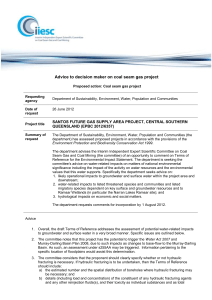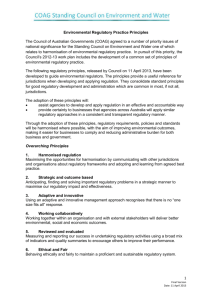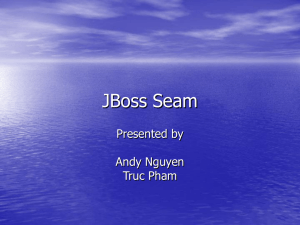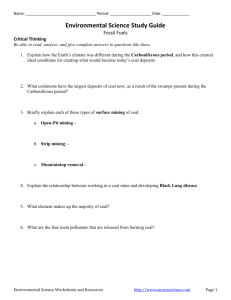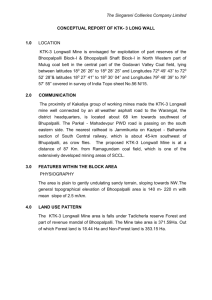CSG Work Plan – Final - Standing Council on Energy and Resources
advertisement
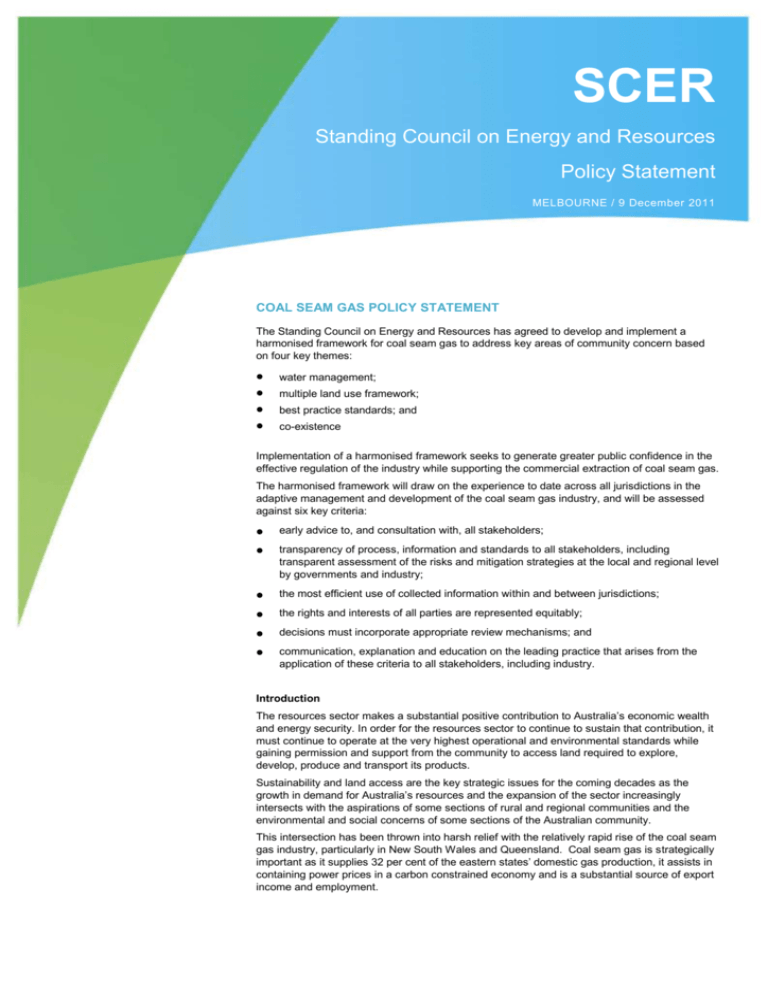
SCER Standing Council on Energy and Resources Policy Statement MELBOURNE / 9 December 2011 COAL SEAM GAS POLICY STATEMENT The Standing Council on Energy and Resources has agreed to develop and implement a harmonised framework for coal seam gas to address key areas of community concern based on four key themes: water management; multiple land use framework; best practice standards; and co-existence Implementation of a harmonised framework seeks to generate greater public confidence in the effective regulation of the industry while supporting the commercial extraction of coal seam gas. The harmonised framework will draw on the experience to date across all jurisdictions in the adaptive management and development of the coal seam gas industry, and will be assessed against six key criteria: early advice to, and consultation with, all stakeholders; the most efficient use of collected information within and between jurisdictions; transparency of process, information and standards to all stakeholders, including transparent assessment of the risks and mitigation strategies at the local and regional level by governments and industry; the rights and interests of all parties are represented equitably; decisions must incorporate appropriate review mechanisms; and communication, explanation and education on the leading practice that arises from the application of these criteria to all stakeholders, including industry. Introduction The resources sector makes a substantial positive contribution to Australia’s economic wealth and energy security. In order for the resources sector to continue to sustain that contribution, it must continue to operate at the very highest operational and environmental standards while gaining permission and support from the community to access land required to explore, develop, produce and transport its products. Sustainability and land access are the key strategic issues for the coming decades as the growth in demand for Australia’s resources and the expansion of the sector increasingly intersects with the aspirations of some sections of rural and regional communities and the environmental and social concerns of some sections of the Australian community. This intersection has been thrown into harsh relief with the relatively rapid rise of the coal seam gas industry, particularly in New South Wales and Queensland. Coal seam gas is strategically important as it supplies 32 per cent of the eastern states’ domestic gas production, it assists in containing power prices in a carbon constrained economy and is a substantial source of export income and employment. Despite the extensive regulation of the sector and the community’s growing dependence on gas within Australia’s energy mix, there is mounting public concern about the safety and environmental impacts of coal seam gas. Governments have been responding to public demands by strengthening regulatory frameworks for unconventional gas and significantly enhancing community engagement processes. More work will be done by governments and industry in response to genuine community concerns regarding co-existence, management of water systems, chemical use, well integrity and hydraulic fracturing and rehabilitation. Approaches to coal seam gas development will continue to be informed by sound science and high quality data, and utilise appropriate risk management frameworks managed by regulators capable of attaining and sustaining the trust of stakeholders in transparently protecting natural, social and economic environments while enabling the environmentally sustainable use of land for multiple compatible purposes. Cooperative Actions Ministers have agreed to develop a national harmonised framework covering the coal seam gas industry with the initial work program based on areas of key community concern encompassing: water management and monitoring; picking up hydraulic fracturing and chemical use; and well integrity and aquifer protection. Nature of the Harmonised Framework The harmonised framework is designed to be flexible to accommodate the range of geographical, geological, resource, social, regulatory and institutional arrangements that exist in each jurisdiction. Successful implementation of the harmonised framework will support public confidence in the effective regulation of the industry while promoting the commercial extraction of coal seam gas. The national harmonised framework will incorporate a combination of leading practice guidelines, protocols, standards, regulations and legislation and it is expected that there will be variations between jurisdictions on how each element is treated. The harmonised framework will not lower existing jurisdictional standards and practices, but will build on and enhance work already underway by state and territory governments. How the task will be carried out The work program has been scoped out below. The scoping describes the stages of work, the anticipated content of each topic, and likely timeframes. Each stage of the project will conclude with a public statement on the progress to date against the scope of the program. The document has been framed with the deliberate intention that the proposals contained within it are flexible. Should additional priority issues be identified, they can be incorporated into the work program as it is progressed, although this may require separate timetabling. 3 of 4 WORK PROGRAM SCOPE Objective A national harmonised framework for: the management and monitoring of water used and produced in coal seam gas production well integrity for coal seam gas hydraulic fracturing practices and procedures for coal seam gas chemical use and management in coal seam gas activities Consultation and development of proposed National Harmonised Framework In consultation with jurisdictions, develop and agree on the proposed: policy statement work program for harmonised framework summary of activities in place or being progressed by jurisdictions community engagement and communications strategy. Research and Analysis A stock take of existing Australian requirements (legislation, regulation, standards etc) for coal seam gas wells in each jurisdiction; and a stock take of current Australian government and industry practices, procedures and reporting requirements to determine: Where common ground already exists between jurisdictions on well integrity and water management and monitoring, including hydraulic fracturing and chemical use for coal seam gas. Where gaps may exist in a comprehensive approach to well integrity for coal seam gas within and between jurisdictions. Identification of the elements of a leading practice approach This work will establish the base-line for analysis. Jurisdictions have agreed that the development of the leading practice approach will, on the basis of lessons learned to date in developing an approach to coal seam gas extraction, need to meet six key tests: Does the approach provide for early advice and consultation with all stakeholders? Does the approach support the most efficient use of collected information within and between jurisdictions? Is there an opportunity for the rights and interests of all parties to be represented equitably? Are all decisions subject to appropriate review mechanisms? and Does the approach provide for transparency of process, information and standards for all stakeholders, including transparent assessment of the risks and mitigation strategies at the local and regional level by governments and industry? Is there a process in place to allow for communication, explanation and education on the leading practice that arises from the application of these criteria to all stakeholders, including industry? 4 of 4 Drafting of a harmonised framework Each element of the framework needs to address identified risks as well as achieve a balance between the rights and interests of different stakeholders. Each of the elements of the well integrity framework arising from significant considerations, including environment, land access, occupational health and safety; reporting requirements; cumulative impacts, performance benchmarking; audit, compliance and accountability; transparency; and data sharing will be drafted to cover: Engineering and design o Commissioning o Hydraulic fracturing o Operational practices o o Decommissioning Other significant considerations The water management and monitoring framework arising from significant considerations, including environment, land use, occupational health and safety; reporting requirements; cumulative impacts; performance benchmarking; audit, compliance and accountability; and transparency will be drafted to cover: Water use, production, reuse and discharge including: o Accounting o Discharge o Measurement o Runoff o Treatment o Reinjection o Analysis and testing o Salinity o Quality and standards o o Storage and containment Waste management such as heavy metal disposal o Seepage o Regional and cumulative impacts o Assessment and predictive methodologies o Risk analysis o Ongoing evaluation Aquifers including: o Protection o Baseline establishment o Monitoring Chemicals and contaminants including: o Use o Reporting o Transparency o Measurement Completion Date: June 2012 Evaluation and consultation Evaluate options where identified and consult with stakeholders on the draft proposal. Final paper and recommendations to SCER for publication of a national harmonised framework Based on the analysis, identify possible dates for the introduction of initiatives to address gaps in existing arrangements by individual jurisdictions Completion Date: September 2012

